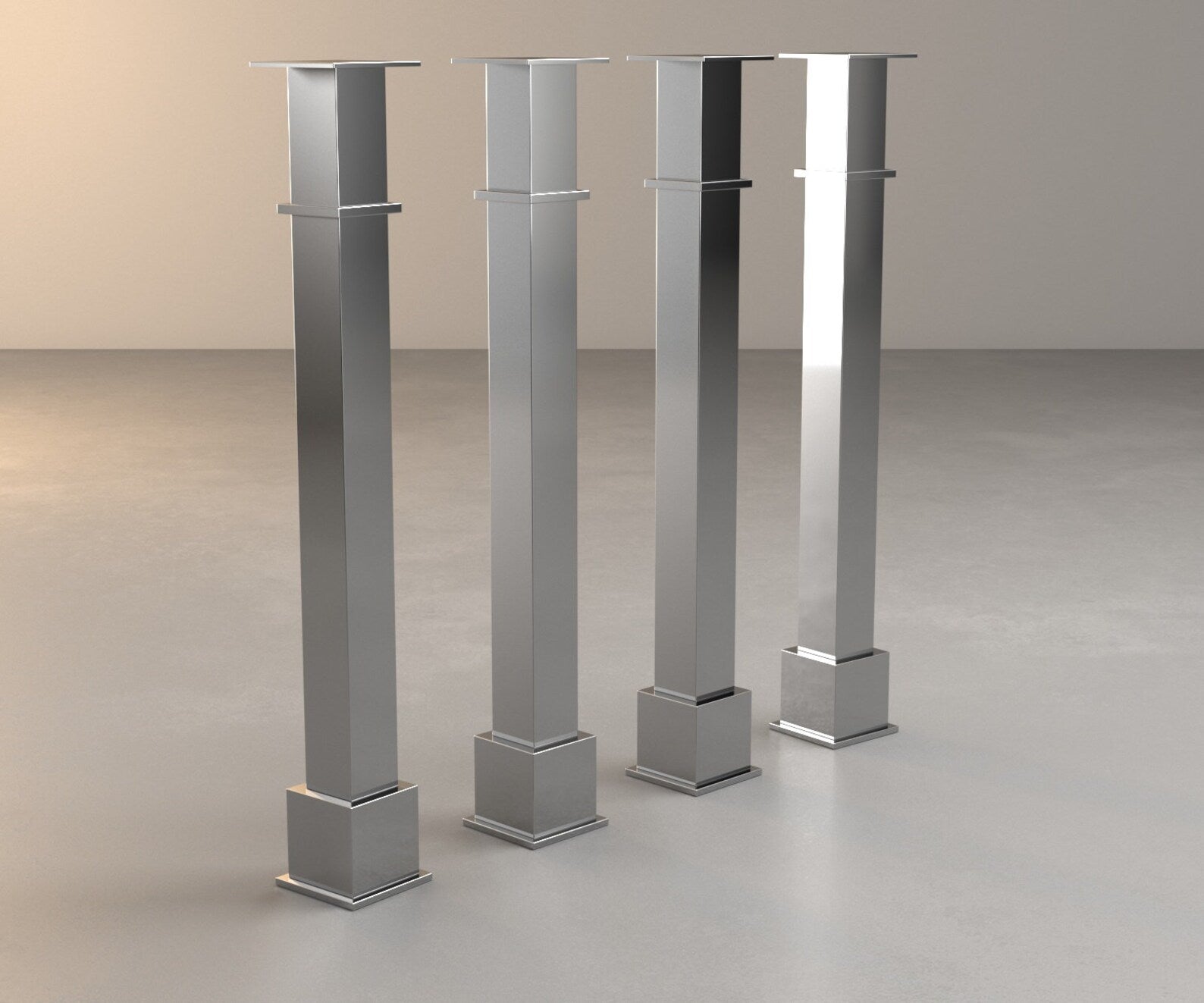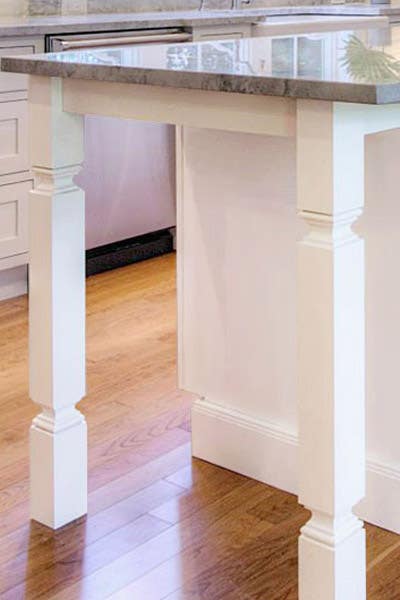Trick Considerations for Discovering the most effective Legs For Kitchen Island for Your Design
When selecting the excellent legs for your kitchen area island, a number of crucial factors to consider come right into play that can considerably influence both performance and looks. The option of material, design, and height need to line up with your total kitchen area layout to ensure a harmonious look. Furthermore, security and upkeep needs are crucial for lasting use and simplicity of care. Understanding these aspects can improve your kitchen's usefulness and visual charm, yet the subtleties of each factor to consider can often be ignored. What effects might these choices carry your cooking area's general atmosphere?
Determine Your Design Preference
Establishing your style choice is crucial when choosing the ideal legs for your kitchen island. The legs of your kitchen island not only serve a functional objective yet also add dramatically to the total visual of the room. Identifying your layout style-- be it contemporary, rustic, conventional, or commercial-- is crucial.
For a contemporary kitchen area, think about sleek, minimalistic legs that match tidy lines and open areas. Standard cooking areas usually favor transformed or ornate legs, which can include a touch of style and class.
Furthermore, think about the elevation and proportion of the legs in relation to the island's surface. Ultimately, your design choice will affect not only the choice of legs but also the general consistency of your kitchen's design.
Select the Right Product
Selecting the best product for your cooking area island legs is crucial in making sure both longevity and visual allure. Different materials offer distinctive benefits, and the selection typically mirrors your layout choices and practical requirements.
Timber is a prominent option, providing heat and adaptability. It can be stained or repainted to match your kitchen decor, making it versatile to different styles, from rustic to contemporary. Nonetheless, wood might call for normal maintenance to protect its look and honesty.

If you look for an one-of-a-kind touch, think about acrylic or glass materials. They can produce an impression of space and agility in your cooking area, making them an exceptional selection for smaller locations - Legs For Kitchen Island. Nonetheless, these options might call for mindful handling and upkeep to stay clear of scratches.
Eventually, the material you select should line up with your kitchen area's total layout, making certain that the legs offer both useful and decorative objectives.
Take Into Consideration Elevation and Percentages
When designing a cooking area island, height and percentages play an important role in guaranteeing functionality and comfort. The conventional height for a kitchen area island normally varies from 36 to 42 inches, straightening with conventional counter elevations or bar heights, specifically. This dimension is vital for harmonizing with surrounding stools and countertops, allowing convenience of usage during meal prep work and social communications.
In addition, the island's proportions must complement the general cooking area design. Take into consideration the ratio in between the island's size and size, guaranteeing it offers sufficient surface area without crowding the cooking area.
Additionally, the elevation of the legs or base can influence the aesthetic allure and functionality. Taller legs might provide an extra contemporary, airy feel, while shorter ones can stimulate a traditional, based look. Eventually, very carefully considering height and proportions will result in a cooking area island that is both aesthetically appealing and functionally reliable, boosting the overall style of the space.
Assess Security and Durability
A cooking area island's legs must not only match its elevation and percentages however also give appropriate stability and sturdiness to sustain day-to-day activities. The legs are necessary to the overall capability of the island, as they birth the weight of the kitchen counter and any type of extra tons, such as home appliances or food prep work jobs.
When evaluating security, it is crucial to consider the leg style and material. Sturdy steel or solid wood legs usually provide remarkable stamina contrasted to lighter products like engineered wood or plastic. Furthermore, a larger base can boost security, reducing the threat of tottering or tipping throughout use.
Sturdiness is similarly crucial; the legs should resist wear and tear from day-to-day use. Think about coatings that protect against scrapes, dents, and wetness, specifically in a kitchen environment. In addition, review the top quality of building and construction, such as joints and fastenings, which can dramatically affect the legs' long-lasting efficiency.
Eventually, investing in well-crafted legs that focus on security and sturdiness will ensure your kitchen island remains a reputable work space for several years ahead, boosting your culinary experiences while preserving aesthetic appeal.
Factor in Upkeep and Treatment
Maintenance and treatment are important factors to consider for making sure the longevity and efficiency of kitchen area island legs. When selecting legs, it is important to examine the products used, moved here as different options call for varying degrees of upkeep. For example, wood legs may require periodic refinishing or sealing Your Domain Name to protect against wetness damage and scratches, while steel legs may need normal brightening to preserve their shine and protect against corrosion.
Furthermore, the coating applied to the legs can influence upkeep needs. A high-gloss covering might be less complicated to tidy yet might reveal finger prints and scratches much more conveniently than a matte coating. It is recommended to select products and surfaces that enhance your way of living; as an example, if you regularly organize events, go with durable materials that can endure deterioration.
Furthermore, think about the cleansing process involved in maintaining these legs. Smooth surfaces usually need minimal effort, while detailed layouts may accumulate dirt and grime, demanding even more labor-intensive cleaning methods. Legs For Kitchen Island. Ultimately, factoring in the maintenance and care needed for your selected kitchen island legs will certainly not only enhance their visual charm however likewise guarantee their practical stability with time
Final Thought
In verdict, picking the optimum legs for a cooking area island necessitates mindful consideration of various elements, consisting of design style, material choice, stability, upkeep, and height. Each aspect plays a vital role in guaranteeing that the legs not just improve the visual appeal of the cooking area however likewise supply the required support and sturdiness for day-to-day use. A knowledgeable decision will inevitably contribute to a functional and visually pleasing cooking area setting.
The legs of your cooking area island not just serve a functional objective but also add significantly to the general visual of the area.Upkeep and care are critical considerations for making certain the longevity and performance of kitchen island legs. Wooden legs may require regular refinishing or sealing to protect against dampness damages and scratches, while steel legs may need routine polishing to preserve their sparkle and stop corrosion.
Eventually, factoring in the maintenance and care required for your picked kitchen area island legs will not just improve view it their visual allure however also guarantee their practical stability over time.
